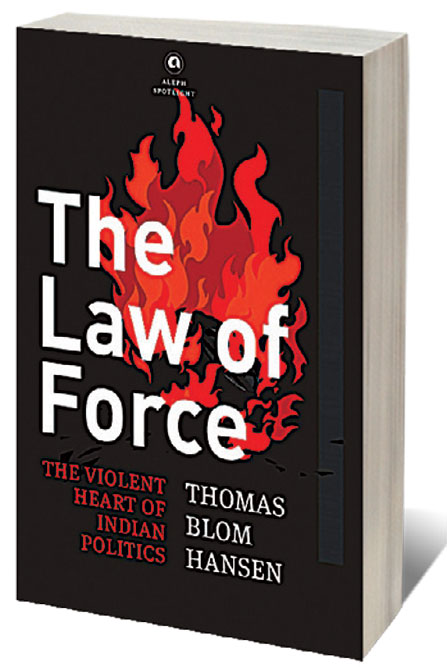THOMAS BLOM HANSEN is one of the world’s foremost scholars of Hindu nationalism. Which is why his books continue to generate tremendous interest among academics and non-academics alike. His latest one, The Law of Force: The Violent Heart of Indian Politics (Aleph; 176 pages; Rs 499), which released recently and traces the chequered history of political violence in India, argues that the current fissures and tensions in the country are nothing new, but a manifestation of what is embedded within. Simply put, the arguments in the book are as implosive as they are revelatory.
This work is a sharp study of the widening gap between the goals of what Hansen calls the illiberal forces at the helm and the rights enshrined in the Constitution. His critique is also a blistering attack on the Government, which the Stanford University professor describes as “a regime of low-intensity terror”. “No. That is not an exaggeration. The attacks on Muslim neighbourhoods in Delhi in 2020, the incredibly violent harassment of Muslims in Uttar Pradesh by police and self-styled vigilantes and similar incidents show the active complicity of state authorities in creating a climate of fear among minority groups and an atmosphere of impunity among Hindu vigilantes,” the 63-year-old anthropologist tells Open.
He adds, “That is very dangerous and it reflects the fact that many people in the BJP and RSS believe in power, not in democracy. In the years before the Nazis seized power (by the ballot, don’t forget), their vigilantes and stormtroopers had been allowed to roam the streets and terrorise socialists, communists, Jews and anyone opposed to their agenda. They created a sense of chaos, an atmosphere of fear of ‘hidden conspiracies’ threatening ordinary Germans that Hitler then seized on when imposing draconian measures to ‘restore order’.”
Notably, over the decades, Hansen has done extensive field studies in western India, especially Pune and Aurangabad, and has collaborated with other experts in the field, including Christophe Jaffrelot and Angana Chatterji. His previous works on India include The Saffron Wave: Democracy and Hindu Nationalism in Modern India (1999), Wages of Violence: Naming and Identity in Postcolonial Bombay (2001) and Urban Violence in India (2005).
This new book argues that Partition was not a ‘catastrophic aberration’, but ‘the eruption’ of the ‘ghastly truth’ of Indian political life: public violence. He hastens to add that he is not exonerating the colonial rulers of British India over driving deeper wedges in Indian society along religious lines. “I completely agree that British colonialism created conditions that allowed for a re-imagining and consolidation of religious affiliation into larger and ‘simplified’ entities that became pitted against each other as mortal enemies in a way that was not the case before the 19th century. The British actively encouraged organisation along community lines, and they played communities against each other, yes. That is well established by scholarship in the past many decades.” At the same time, he adds, “I follow my friend [and academic] Shruti Kapila’s argument that we need to rethink the significance of Partition in the political life of India.”
What the rise and dominance of the BJP demonstrate is that partition was a foundational event in the life of the Indian nation state, an event that still reverberates through everyday politics and social relations, says Thomas Blom Hansen, anthropologist
Share this on 

“What the rise and dominance of the BJP demonstrate is that Partition was a foundational event in the life of the Indian nation state, an event that still reverberates through everyday politics and social relations. Not just as deep and injurious memories of violence as has been explored in admirable ways in the past decades, but by providing a matrix for political enmity, a ‘violent fraternity’ as Kapila calls it,” says Hansen. His view is that Partition and the decades of strife that preceded it provide an incredibly stable repertoire of myths of ‘the other’, and horrible rituals of killing and abuse that are repeated each time there is a communal clash anywhere in the country.
Hansen adds, “The BJP was the first political formation to actively and aggressively tap this vein of memories and structure of enmity that had been actively played down by Congress for many years in order to build the nation. But trauma and emotion on that scale cannot easily be tucked away. It will return as we know from many other parts of the world.”
Although brief at 176 pages, The Law of Force makes for a fascinating read. Besides the rigour behind this work, its clarity is unmistakably profound. It says that for the majority of Indians, rajniti is a less familiar word used to denote politics, and that they are more aligned with the expressions such as siyaasat (which has connotations of strategy/trickery) and ‘politics karna’ (to do politics). How did he reach this conclusion? “The short answer is spending a lot of time with political activists and ordinary people. In Maharashtra, where I have done most of my work, terms like rajkaaran and rajniti are used (often negatively) for the world of politics, for political life and activity as such. However, I have found that political activity and activism were often described by the term ‘politics karna’, a terminology that really has become a part of the vernacular. Siyaasat is also widely used as a colloquial term by Urdu and Hindi speakers,” he says.
Hansen uses fictitious names to protect the identities of many of those interviewed because, he says, the respondents had expressed their fear of being identified. He points out, “That has been the case with most of the people I have met over the years who belong to social or religious minorities, especially Dalits and Muslims. Some of these individuals have less fear because they belong to political parties or movements that have some standing and that they hope can shield them to some extent.” He adds, however, that in situations of heightened conflict, during riots or draconian police action, individual status matters less than your social category and everybody belonging to these communities can become a target.
The Law of Force dwells on democratic deepening in India in the 1980s and the 1990s thanks to those who weren’t in power before getting an opportunity to do so, and yet it looks at the flip side: what he calls ‘substantialisation’ of communities. It is here that he talks about the process whereby communities became less concerned about recognition of their own standing vis-à-vis those above or below them in the caste hierarchy and were more focused on developing a story of their own community as unique, founded around certain myths, virtues, heroes, certain ways of being, eating, speaking, etcetera. “That is, turning one’s community into a more bounded and horizontally integrated whole, like an ethnic community, you might say. One clear example is the evolution of Yadav identity across north India as documented by Lucia Michelutti and others,” he says, emphasising that violence still remains at the core of Indian public life. As with the latest trends, he quotes Freud on fascism to hint that in India most rioters are emboldened by a certain permission to act without constraints and moral injunctions. He says most streetfighters are not essentially destitute, but those who relish the freedom to get a thrill from assaulting others.
Not all lives have the same value in India and the lives of Dalits, tribals or Muslims are not considered grievable in the way that an upper-caste Hindu life would be, says Thomas Blom Hansen
Share this on 

Denmark-born Hansen, who has previously taught at Yale University, also rues the routine banalisation of the Gandhian language of self-sacrifice. “Whatever you think of the man, he took personal risks, his body was an active part of political life, as it were. Not so today where the Gandhi gesture is largely rhetorical. It is interesting that the whole demonetisation affair was framed as a national sacrifice and that people were asked to endure hardship. In my view, demonetisation is as much about a certain conservative dog-whistle politics that was fundamentally protecting the rich and the powerful by conjuring up a target of the small-time corrupt bureaucrats, business people and dalal [middle men] figures who would now lose ill-gotten wealth,” he says.
The book looks into the elation experienced by many middle-class Hindus when members of minority groups die or are imprisoned. Hansen says that he is quite worried about the shrinking space for dissent and violation of civil liberties. He is also anxious of “the easy political conformism of large sections of the middle class (and the majority of the press) seemingly content with a constant flow of material improvements and an official vindication of widespread prejudices regarding Muslims, Dalits and that new peculiar and shapeshifting threat: the urban Naxal—a label that can be affixed to anyone disagreeing with the government or critical of aspects of the social order.”
On the farmers’ protests he says: “On the one hand, these protests are in line with a very long tradition of protests in India, of asserting one’s right to speak up and dissent. That is a deeply entrenched sensibility, entirely in line with the Constitution, still the heart of ordinary political life in India and not easily curbed or delegitimised as the BJP is now learning the hard way.” He adds, “However, it is one thing to defend one’s livelihood and economic interests, and another to defend broader principles, such as ‘the right to have rights’, a right that would also apply to communities that you in everyday life have a more antagonistic relationship with. Here the recent spectacle of farmer leader Rakesh Tikait from western Uttar Pradesh and his followers apologising to the Muslim community [and fellow farmers] in Muzaffarnagar for the violence that Jat farmers and other Hindus perpetrated in 2013 is potentially significant and points to the possibility of alignments and forms of political friendships that reached beyond community sentiments.”
The book calls for police reforms in India, which, according to Hansen, is long “overdue”. The author notes that since 1980 there has been a steady stream of commissions recommending thorough reform of policing, the training of recruits, the organisation of the forces, the strengthening of relationships with the communities that are policed, reduction of the high number of custodial deaths and the routine violence and abuse by police. He regrets that no action has been taken and it is a true mystery that none of the political forces that fight for the protection of the poorer sections and minorities have made this a key demand. “The number of Muslims in the police is negligible but Dalits are gradually having a larger footprint in policing in the states where Dalits are socially upwardly mobile. However, a single Dalit policeman cannot change the culture of policing, which remains excessively violent and in daily violation of the spirit of the Constitution,” Hansen explains.
Talking about the force of law being rarely applied equally or impartially in India, he says, “Not all lives have the same value in India and the lives of Dalits, Tribals or Muslims are not considered grievable in the way that an upper-caste Hindu life would be. As I mention in the book, when members of minority groups die or are imprisoned the reaction from many middle-class Hindus is often approving and one finds common remarks like ‘someone needs to teach these people a lesson’, or ‘they only understand force’, or ‘these people are goondas and criminals’.”
The book also puts the blame on the Left in conniving at largescale and perpetual human-rights violations in the name of national sovereignty. “I am not entirely sure what the position of the parliamentary Left is on the future of Kashmir, or the many decades of the Armed Forces Special Powers Act that has given the security forces a free hand to act with impunity in the Northeast, in Kashmir and in other ‘disturbed areas’. As you may know, India has a very long history of dismissing any critique of its human-rights record as undue interference in the Indian sovereign sphere,” Hansen says.
The Law of Force also discusses the media onslaught on Tablighis in Delhi at the height of the Covid-19 pandemic as a dangerous ‘episode’ in the long history of ‘violence at the heart of Indian public life’. “If a community is portrayed as physically endangering the majority by being vectors of disease or contagion, that creates a whole new level of enmity and potential justifications for the removal of this community from mainstream society. This was what happened to Jews in Germany who were accused of spreading disease and of being a burden on the German nation,” Hansen says. This book is sure to kick up a storm—and maybe, debate, too.

/wp-content/uploads/2021/03/ViolentIndian1.jpg)

/wp-content/uploads/2025/07/Cover-Shubman-Gill-1.jpg)














More Columns
Shubhanshu Shukla Return Date Set For July 14 Open
Rhythm Streets Aditya Mani Jha
Mumbai’s Glazed Memories Shaikh Ayaz